The Xiaomi Mi Note Pro and Mi Note Review
by Joshua Ho on September 11, 2015 9:00 AM ESTSystem Performance
Performance may be a rather nebulous thing - there are a number of factors that affect the performance of a smartphone in everyday tasks. One of the single most important components to overall performance is the SoC (System on a Chip). This one package will usually contain the CPU, GPU, DRAM interface, a number of fixed-function blocks, various DSPs, and other processing engines. Usually, DRAM itself is also mounted on top of the SoC package in a package on package (PoP) configuration. In order to test this and more in a smartphone, we rely on a set of benchmarks that are accepted within the industry that can reasonably represent smartphone performance. Of course, the state of the art in benchmarking is always changing, but we can say with reasonable confidence that if a smartphone or tablet performs well in our benchmarks that the SoC will be a good foundation for a smooth experience. Of course, if an OEM then decides to run unoptimized Android UIs on top of this SoC then any performance advantage could be wasted. In the case of the Mi Note, we’re looking at a relatively standard Snapdragon 801 with 3GB of LPDDR3, while the Mi Note Pro uses a more powerful Snapdragon 810 with 4GB of LPDDR4.


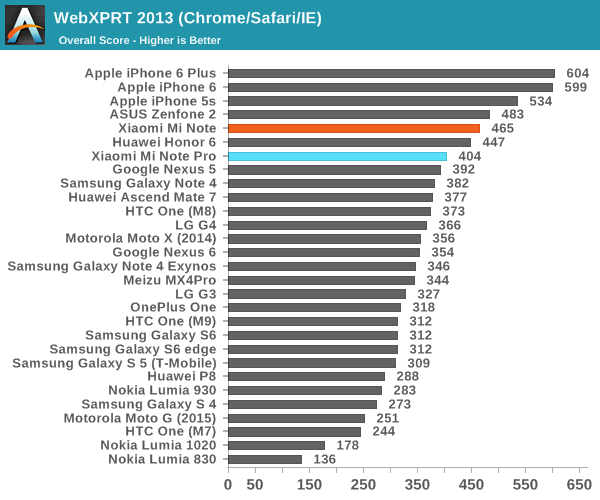
It's interesting to look at these results as we can basically see the differences that result from browser optimizations. It's also important to note here that the Xiaomi Mi Note was run with the Performance mode turned on as otherwise the CPU governor would be far too conservative for good performance. Unfortunately though, it looks like the Performance mode (as opposed to Balanced) is extremely aggressive, setting all cores online and to only use the 2.5 GHz state. Xiaomi needs to provide a more appropriate performance governor for everyday use. It's worth noting here that all benchmarks can be run without the performance governor, but the software will offer to turn it on if it detects a benchmark.
Fortunately, it seems the Mi Note Pro doesn't have these sorts of strange governor settings and performance is in line for what we'd expect from a Snapdragon 810.
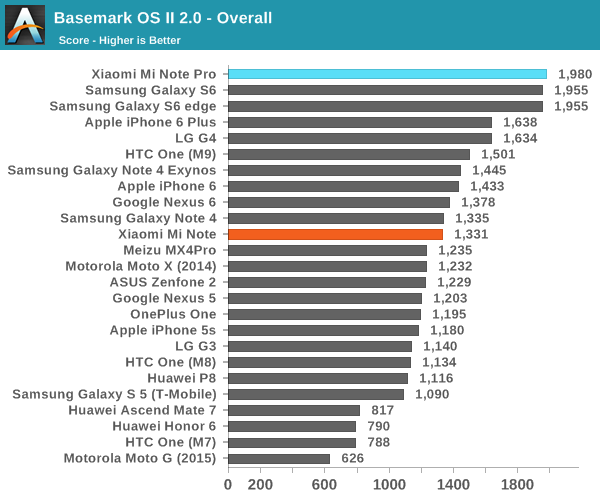
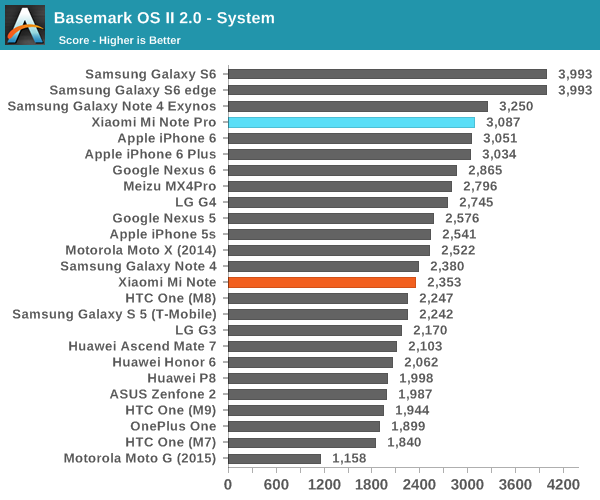

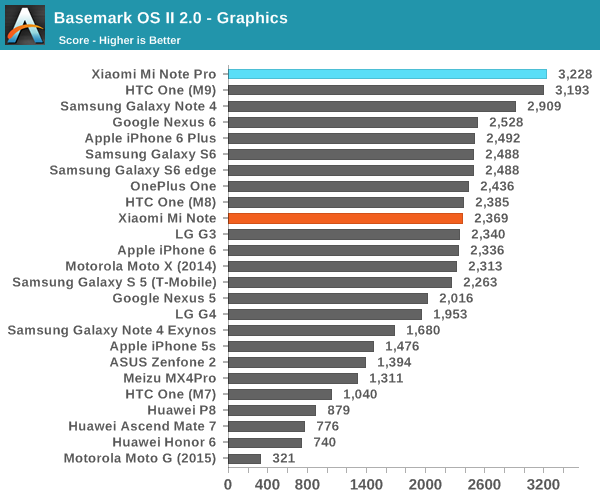
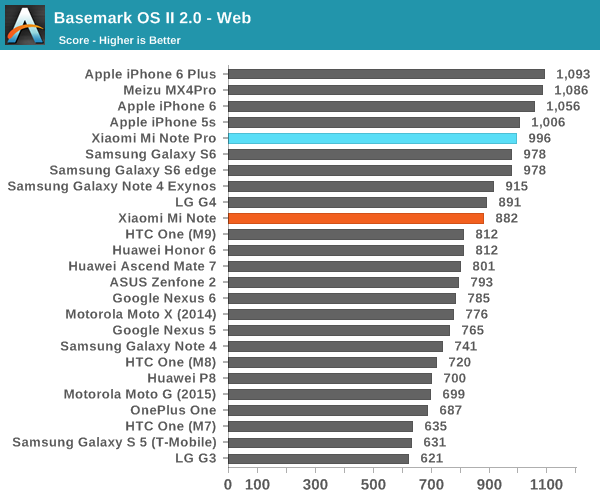
In Basemark OS II we see that performance is roughly estimated to be equal to the Galaxy S6. It seems that most of this is coming from the NAND benchmark aspect and browser optimizations as in the System subtest the Mi Note is around the same level as the Exynos 5433. The graphics subtest shows performance is identical to the One M9, which suggests that the 30 MHz bump in clock isn't going to be particularly helpful.
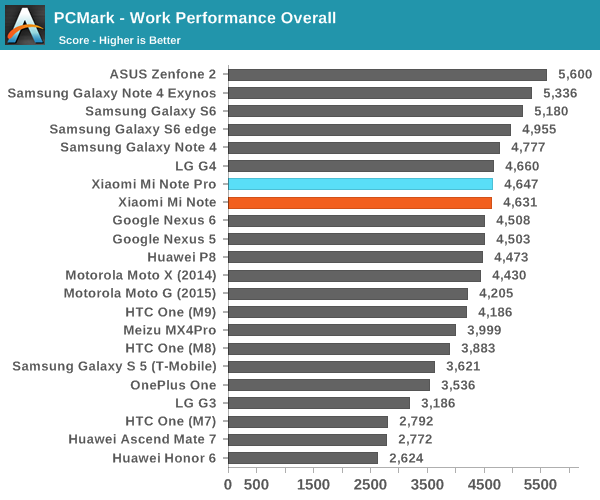
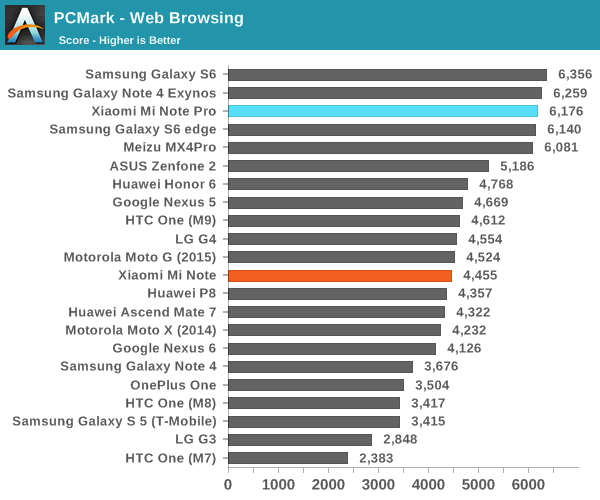
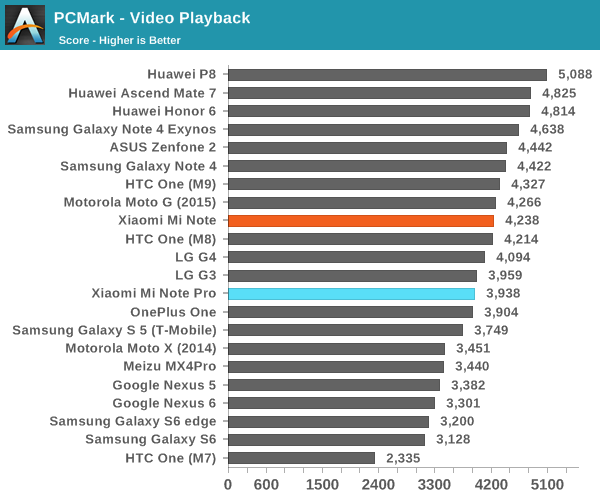
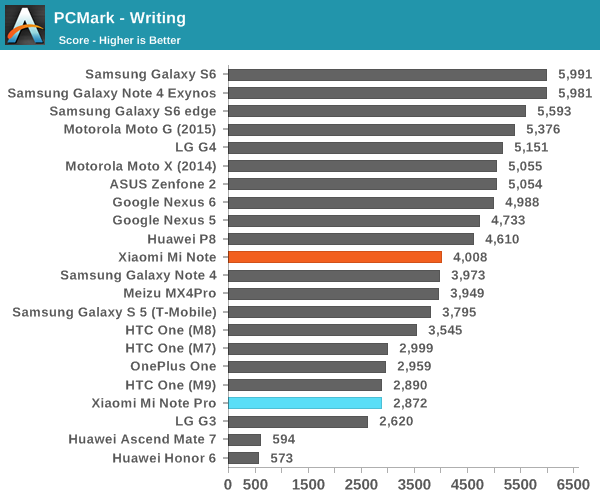
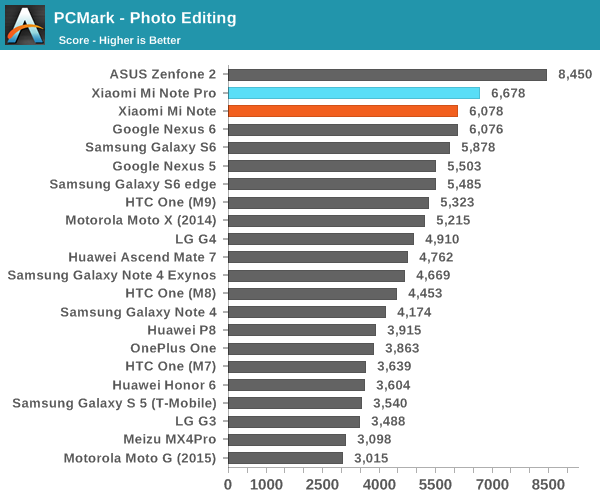
At this point it's pretty fair to say that the Snapdragon 801 is a known quantity when it comes to performance, but when it comes to the Snapdragon 810 it's still in some level of flux. For the Mi Note at least, this is mostly interesting at an academic level as a pure 2.5 GHz 4x Krait comparison relative to the Snapdragon 810. Overall, it looks like the Mi Note Pro is about the same performance as the G4, which makes sense because the governor usually only allows two A57s to stay online in all but the most extreme loads. However, performance has a wide relative variation in cases where the OEM has either invested a lot of time in optimizing their build of Android or not as much. It looks like web browsing is a major point of optimization for the Mi Note Pro as it is competitive with the Galaxy S6 in that test, but in areas like the writing subtest Xiaomi is falling behind somewhat. I suspect this is mostly a software optimization problem as PCMark is extremely sensitive to changes in Android version as seen in the Note 4 and Note 4 Exynos which are surpassing the Mi Note due to an OTA update to Lollipop despite the Mi Note's use of a performance governor.
Overall, performance of Snapdragon 810 in these mostly CPU-bound tasks is acceptable. We can still see some performance gains over Snapdragon 801 and 805 but relative to the Exynos 7420 competition things aren't quite as rosy. Of course, we can talk about software optimization but in Basemark OS II the Mi Note only squeaks by due to a high NAND performance score rather than a strong showing in any SoC performance test. In PCMark we see a similar story of some tests where the Mi Note Pro is doing well, but others where it falls short to give an average score overall. Whatever the case, it's clear that the Mi Note Pro does have a good amount of performance on tap. The Mi Note is also clearly capable of being a strong performer as seen in the performance mode benchmarks, but the balanced governor mode needs to be much better to exploit that performance. Both phones should have enough CPU performance to do pretty much any everyday task.










94 Comments
View All Comments
Mike89 - Thursday, October 15, 2015 - link
Xiaomi phones are not optimized for the US. I bought the Redmi Note 2 and when I got it found it would only do 2G in the US no matter the carrier. For every model number there are numerous sub versions of the same model number for different Countries and for the most part the vendors don't tell you which one they are selling. Mine (from Gearbest) was the China version even though it was stated "worldwide". Doesn't have the right bands or the right bands activated for US use.1010101100 - Thursday, October 29, 2015 - link
Did you even research the product you wanted before getting it? Did take time to check what bands were supported for the product? Did you have knowledge that not all out of state phones might not work within the US? Lastly did you research to see what data speed your carrier provided for the product you were planning to buy? I'm using a Mi Note Pro right now and have no complaints about my data speed since I know for sure at best right now its HSPA+ on T-Mobile or ATT, currently on the GoSmart mobile prepaid network available in NYC. Like someone mentioned earlier majority of our products sold in the US is produced from China for cheap labor and production cost. The design of a certain product can be from US but was not produced in US but from another country mainly China hence the term "Made in China". Leather goods from India or Italy. Surely US is not at a point where it's just stealing credit for the manual labor? I mean Apple has already been stealing credit for where it should be given.irresistible - Thursday, July 7, 2016 - link
After reading this review I decieded to buy an Xiaomi Note Pro for 500€ including all shipping costs and taxes.Today I own an Xiaomi Note Pro for over seven months now and while using it daily, I can assure you the following :
1. Qualcomm Snapdragon 810 has different versions (check here http://www.anandtech.com/show/9388/comparing-snapd...
Xiaomi Note Pro has one of the best version (v.2.1), if not the best version. Therefore the main overheating issue does not exist. From my real-world testing, I assure you that it's not getting warm at 30 degree Celsius room temperature when doing basic tasks (messaging, calls, browsing and so on). When playing taxing games, it will get warm (not hot!) at 30 degree Celsius room temperature. When watching movies for many hours with hardware-acceleration (mandatory in my opinion) your phone will get warm (not hot!). So basically if your room-temperature is about 20 degree Celsius your phone will not even get warm. Were is the overheating issue? If you are gaming 24/7h on max brightness without hardware-acceleration, you might experience throttling. All other scenarios have 0 overheating issues. In my opinion Xiaomi Note Pro is not optimal for heavy daily gaming.
2. Camera
It's okay for most people, but nothing special. Shooting is very quick. Like SNAP (1sec) and picture is taken :). It's true that the low-light performance is not good, but which phone has good low-light performance? Oh, yea you are right, flaghship phones which STARTS at 500-700$.
3. Storage
Non-expandable storage is not always to be seen negatively. Xiaomi Note Pro is 6.9mm thick and it was released at a date were micro-SD slot was not implemented on flagship phones for various reasons. And still to-date there is only a handful phones e.g. Samsung Galaxy S7 which incorporate flagship design with an micro-SD card slot. For the vast majority of users 64GB is more than enough. And those who want more, shouldn't buy this phone.
4. Battery Life
You cannot call battery life: subpar. Why not? This phone is only 6.9mm thick (!!!) and comes with an 1440p display (!!!). And they were able to implement an 3000mah battery, which is huge. But it's also true that it's powerdraw ratio is not that good. Battery lasts about one whole day for most tasks including watching videos (hardware accelerated). You can drastically optimize your battery life with xposed modules e.g. amplifiy, greenify and so on. If you want even more battery life, you can buy Xiaomi Note (non-pro) edition. If you want to do heavy gaming over multiple hours, you shouldn't buy this phone. Games, especially not hardware-accelerated on max brightness will drain your battery fairly quickly. If the battery capacity would be about 2000mah, I would call that sub-par, not 3000mah. Do not forget that this phone is supporting Quick Charge 2.0, your charging time is not that long compared to other phones.
5. Gaming in general
If you are like me and play games on your phone occasionally on the way to work or school or whatever, your battery life will be fine. But if you are sitting down on breaks or e.g. in a park with super nice sunlight playing 3-5 hours at max. brightness your favorite JRPG, your battery won't last a whole day. If you are me, you would solve this issue by connecting an sleek powerbank from Xiaomi :)
If you have any questions, feel freeeeeeeeeeeeeeeeeeeeee to ask meeeeeeeeeee.
I would like to end this write-up with the following:
Xiaomi Mi Note Pro is the best 1440p 5.7" smartphone in the world. Only Galaxy Note 5 can compete. (summer 2016)
Coffeemilotea - Saturday, October 8, 2016 - link
Hi is your phone with Android 6.0 Marshmallow or KitKat with MIUI 8? Thanks.